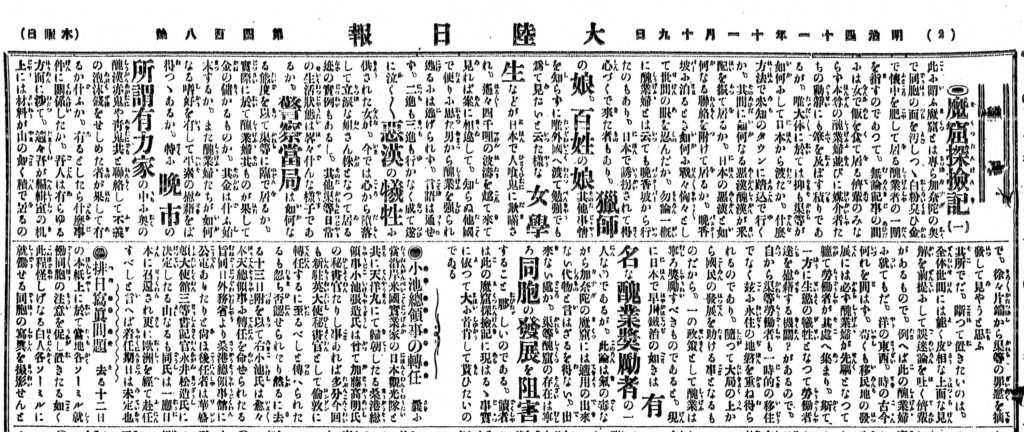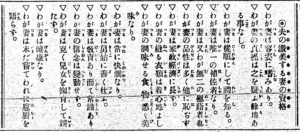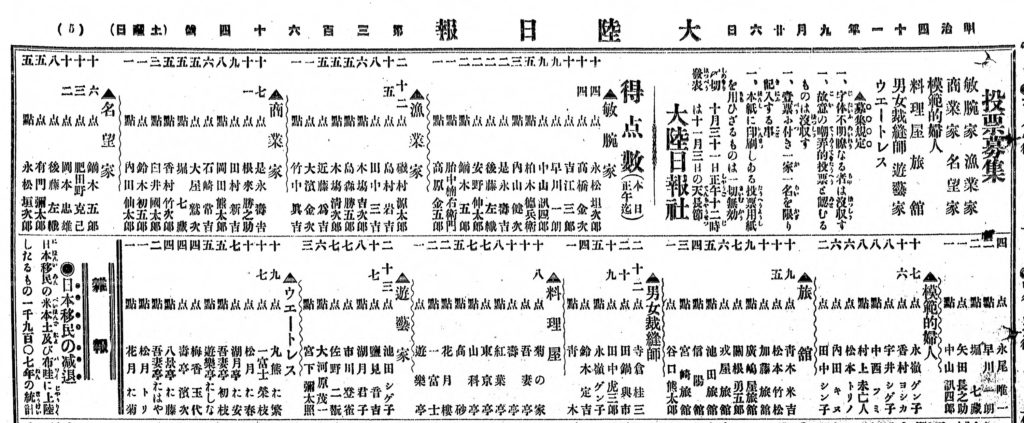Main Body
Sex Workers, Waitresses, and Wives: The Disciplining of Women’s Bodies in the Tairiku Nippo (1908-1920)
Ayaka Yoshimizu | University of British Columbia[1]
Browse the UBC Open Collections Tairiku Nippō digital archive here.
In Japanese migrant communities in early twentieth century North America, Japanese-language newspapers were an important source of information and knowledge, providing international and local news, including telegraph news from Japan and other parts of the world, stories of Japanese communities in North America, and local issues that affected the lives and work of the immigrant population. It was also a provider of entertainment, a promoter of community businesses, and a site of social interaction, having large sections devoted to advertisements of Japanese-owned businesses, reviews, gossip, and literary works. In fact, Japanese language newspapers were a site of amateur literary practice for migrants who had limited access to mainstream publications due to cultural and linguistic differences and a lack of resources. Stories contributed by migrant writers were featured in serialized columns called tsuzuki-mono, following a common literary practice in Meiji Japan.
What was unique about the Japanese migrant community in North America at the turn of the 20th century was that it consisted disproportionally of a large group of bachelor male labourers and a much smaller group of women. This resulted in the prominent presence of women working as restaurant waitresses, barmaids, and sex workers to serve the interests and needs of men, as well as a number of literary writings that explored the themes of male labourers’ romances with Japanese women in the nighttime entertainment businesses, including the sex trade.[2] Sometimes “fallen women” themselves were protagonists of stories that were sympathetic to their situations.
For example, Shoson Nagahara, a young, male novelist from Yamaguchi Prefecture, wrote the novella “Osasto-san” between 1925 and 1926 for Rafu Shimpo, a daily newspaper based in Los Angeles. The story features Osato, who migrated to the United States to join her husband only to realize that he is jobless and frequents gambling places. She ends up in the red light district of Little Tokyo, working as a barmaid, and later manages her own bar.[3] Another example would be the short story entitled “Kantsu” (adultery), which was published in April 1911 in Seattle’s Taihoku Nippō and written by a presumably female author who published under the penname “Woman Aki.” It narrates in the first-person voice a story of a married woman who gets involved with a young, kind man behind the back of her drunk and violent husband.

However, newspapers published not only fictional novellas submitted by readers, but also tabloid news and neighbourhood gossip. Just like their counterparts in Japan, migrant newspapers targeted fellow commoners rather than elites, exposing private details of individuals’ “immoral” behaviour, particularly that of women, and turning sex workers, barmaids, restaurant waitresses, and wives in extra-marital relationships into objects of criticism and condemnation.[4] In this way, Japanese language newspapers in early-20th century North America were micro-institutions that produced didactic discourses of “ideal” and “bad” womanhood for migrant communities by disciplining women’s bodies according to the ideology of ryōsai kenbō, or in English, “good wives, wise mothers.”
Such effort can be discerned in early issues of Vancouver’s Tairiku Nippō (Continental Daily News), which ran between 1907-1941.[5] In one example, Nippō catalogued for its readers “Qualifications for the Ideal Wife Who Is Worth Her Husband’s Praise” with sixteen bullet points in a small section written in the first person voice of a married man, delineating the following criteria: “My wife has a modest appearance”; “Her chastity is indubitable”; “She is my only and best assistant”; “She sews the most comfortable clothes”; “She cooks delicious food”; “She educates children without flaws.” Women were severely criticized for transgressing these standards.

The most explicit and extensive example of the disciplinary effects of the Nippō on women’s bodies was a series called “Makutsu Tankenki,” or “Exploration of Devil Caves.” Written by Shohei Osada, the series was published over seventy-one installments between November 19, 1908 and February 13, 1909 [Figure 1]. With detailed documentation of Japanese men and women, or “devils” and “bitches” respectively, involved in the sex trade in Canada at the turn of the twentieth century, the series attempted to identify “deviant” individuals, shame their behaviour, and ultimately eradicate prostitution among Japanese in Canada. The presence of Japanese “devil caves,” referring to brothels, were perceived as a contributing factor to white people’s racism against the Japanese. In fact, the series came out soon after the anti-Asian riots of 1907, which led to the Hayashi-Lemiueux Agreement in 1908 and the restriction on the number of Japanese migrants admitted to the country.
The Devil Caves series was one project commissioned by Nippō’s new owner, Yasushi Yamazaki, who took over a paper that was already nearly bankrupt after being founded as recently as June 1907.[6] Issei immigrant Katsuyoshi Morita testified that the previous owner “Mr. Kashiwa” had almost been forced to leave his business because the “article on public morals” he published resulted in “threats” by some forces and the operation became difficult to continue.[7] It seems that the new owner, Yamazaki, who had purchased the business in March 1908, did not submit to such pressure and rather responded to it by directly addressing issues of “immoral” activities in the community. In fact, Yamazaki had previously managed another daily newspaper called Hokubei Jiji based in Seattle. Around this time, Japanese sex workers, as well as brothel owners and managers, guards and pimps, were highly visible in downtown Seattle, and the profit made in the brothel businesses had a strong economic influence in the community. Jiji in turn was sponsored by the underground business, which was one of the main reasons why Yamazaki left the paper.[8] When he made a fresh start with Nippō, Yamazaki was likely as strongly determined to fight against prostitution as he was to sell copy.
The Devil Caves series exposed the identities of “devils and bitches” with their names, nicknames, and backgrounds, including their hometowns. Stories were written in a tabloid style with hyperbolic language, highlighting individuals’ names and some dramatic phrases in big and bold fonts. Lurid descriptions of murder incidents, internal conflicts, and relationship scandals emphasized the violent, barbaric and “abnormal” character of the “bitches.” Other stories were comical or entertaining, suggesting how foolish and nonsensical the brothels were. The series proved popular enough with readers for the first installments to be re-edited and reorganized alongside portraits of local sex workers into a book with a new title, Kanada no Makutsu [Brothels in Canada] published in 1910. A second column series consisting of 32 installments followed daily from March 1 to April 6, 1912.

Outside of “Exploration of Devil Caves,” Nippō routinely disciplined women by presenting examples contrasting deviant and ideal womanhood in news reports, gossip, and opinion pieces. The paper repeatedly punished women for committing adultery, running away with their lovers, overly exposing their skin, or even just laughing with their mouths open on the street. At the same time, Nippō was quite rigorous in announcing the best women in the community. For example, it regularly called for readers’ votes to determine model citizens in the fellow migrant community; for women, there were categories for “ladies” and “waitresses.”
Japanese restaurants were ambiguous places of sexuality where servers could potentially be expected to entertain male customers in roles similar to those of geisha, or could just be waitresses, in which case they should meet the customers’ notions of ideal, “virtuous” women. Gossip written by Nippō’s staff and contributed by readers often included information about beautiful or graceful waitresses. There was also a column series called “Ryōriya Nozoki” (A Peek at Restaurants; January 6 and early February, 1908), which offered reviews of Japanese restaurants elaborately detailing their food, service, and of course their waitresses. Women’s bodies, therefore, were often turned into discursive and material sites of discipline by male writers, editors, publishers, and very likely, both male and female readers of community papers like the Nippō.
But women were not always passive victims of disciplinary power. There were women writers who wrote about and for women. The most well-known example among those who contributed to Nippō was Toshiko Tamura, whose award-winning debut novel Akirame (“Resignation,” 1911) featured a female protagonist who pursued a professional writing career against the “good wives, wise mothers” ideology and addressed transgressive sexualities, including adultery and female homosexuality. As a writer she outgrew her male partner Shogyo Tamura, who was also a writer and senior compared to Toshiko both in age and in writing career. She moved from Tokyo to Vancouver in 1918 to follow journalist Etsu Suzuki, who had quit his previous work at Asahi Shinbun newspaper company and just joined Nippō. This also meant that they were starting a new life as a couple outside their marriage back home.[9] While she became less active as a writer in Canada, being removed from the much larger and more vibrant Japanese language literary community in Japan, Toshiko contributed to Nippō and played a leadership role as a feminist writer. Most prominently, she started a weekly column series “Saturday Women’s Section” in August 1919, in which she wrote to fellow Japanese migrant women to raise awareness about women’s rights.[10]

What was less visible but equally powerful, however, was the ambivalence of newspaper representations of women. These representations had been initially produced to serve patriarchal institutional purposes of controlling women’s bodies in the migrant community, yet simultaneously undermined male writers’ condemnations of “bad” women. For example, the photographic portraits of women in Japanese brothels included in Kanada no Makutsu are far from stereotypical imageries of aggressive, vulgar and deceitful “prostitutes.” Quite contrary, the women present themselves with sophistication, tranquility, and dignity, making us question the discursively constructed wall that separates “bad” women from the rest. Unfortunately, their image quality is painfully poor as these portraits come from a photocopy of the original book [Figure 4], which to my knowledge is the only copy in Canada that is publicly available today. Regardless, they resist the historical erasure of their presence and participation in the social, economic, and cultural development of the early Japanese migrant community and the larger North American societies in which they lived.
- I would like to acknowledge that this essay is built on my past collaborative work with Julia Aoki. We presented a more elaborated discussion on Shohei Osada’s column series “Exploration of Devil Caves” at 2015 BC Studies Conference (Richmond, BC). ↵
- Satae Shinoda, “Nikkei Amerika bungaku no rekishi,” American Review 14 (1980), 67. For an in-depth study of the history of Japanese sex workers and barmaids in North America from this period, see Kazuhiro Oharazeki, Japanese Prostitutes in the North American West, 1887-1920 (Seattle: University of Washington Press, 2016). ↵
- This story has been translated in English by Andrew Leong and included in Lament in the Night (Los Angeles: Kaya Press, 2011). ↵
- Satoru Saito notes that smaller-sized papers known as koshinbun emerged in the 1870s in Japan had a column called zappo (miscellaneous reports), which collected tabloid news and neighbourhood gossip and covered topics such as local crime, adultery, the pleasure quarters, and even domestic quarrels (“Newspaper serials in the late nineteenth century,” Cambridge History of Japanese Literature edited by Haruo Shirane et al., Cambridge University Press, 583-587). ↵
- Earlier issues of Tairiku Nippō typically consisted of six, or occasionally eight, pages and sold at five cents per issue, thirty-five cents per month, two dollars per six months, and three dollars and fifty cents per year. While its circulation is unknown, other writings on this publication suggest that it was quite influential among the Japanese-speaking (im)migrants in Vancouver (see Mitsuru Shinpo, Norio Tamura and Shigehiko Shiramizu, Kanada no Nihongo Shinbun, Tokyo: PMC Shppan, 1991). Nippo and Kanada Shinpo were the two largest, rival papers until the late 1910s when Shinpo “lost” its battle with Nippo and discontinued its operation (Shinpo et al., 48-56). Shinpo et al. argue that Nippo had an advantage over Shinpo, as it had a strong affiliation with the Vancouver Buddhist Temple and about 90% of the Japanese in Vancouver then were Buddhists, while Shinpo was Christian-leaning and supported by a small group of Christian readers (55-56). ↵
- Mitsuru Shinpo, Norio Tamura and Shigehiko Shiramizu, Kanada no Nihongo Shinbun (Tokyo: PMC Shppan, 1991), 49-50. ↵
- Powell Street Monogatari, Burnaby: Live Canada Publishing, 1988, 78. The exact content of this article is not elaborated in Morita’s account. ↵
- Kanada iminshi shiryo, Tokyo: Fuji Shuppan, 1995-2000, 115. ↵
- See Kudo Miyoko and Susan Phillips (Bankuba no ai: Tamura Toshiko to Suzuki Etsu, Tokyo: Domesu Shuppan, 1982) for a detailed account of the couple’s life in Vancouver. ↵
- Kudo, 88. ↵

